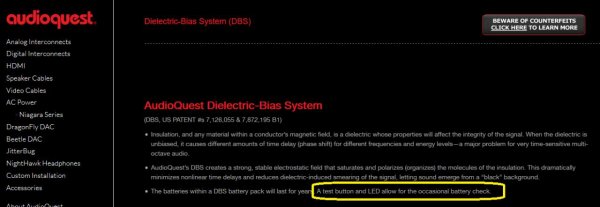Thank you, Bill. Polite and professional as always.
Do I understand you correctly?
- Audioquest cables are made and tested to the same standards as "certified" cables.
- You refuse to pay for the actual certification / labelling, though by all appearances you could well afford to do so with your pricing structure. This is because you are philosophically opposed to the "money grab" by the HDMI consortium.
I can see how this could be interpreted as a "money grab" on your part instead. I do see a counter-argument, that not having the certification could be costing you more in sales than the cost of the certification, especially as you say that most of your sales are at the "reasonably" priced end of the market where you face competition from certified products.
(If anyone who knows me thinks I'm becoming a high-end apologist, rest easy, I'm not. In the case of Audioquest, I still remain sceptical about many of Bill's claims.)
HDMI LLC sets standards, and HDMI LLC has an authorized lab that can be used if desired (which AQ does), but for the most part, claims as to Standard Speed and High Speed (or the previous language for HDMI 1.3 and earlier versions) was self-policed. Of course this meant that as with most product categories, there would be some companies whose products didn't meet spec, or which lied about their products' capability.
If HDMI LLC was minimally raising their adopter charges in order to now better fund policing the marketplace, I would be all for it !!! Unfortunately, HDMI, UL, DPL, and I believe THX though I have not been approached by them, have designed for-profit schemes to charge significant fees to those who do make in-spec cables, while doing next to nothing to stop suppliers of out of spec cables. This is backwards, charging blackmail/protection to the good guys.
AudioQuest has always played the game to the letter of HDMI LLC's requirements. We don't call our field-terminatable HDMI cable by the HDMI name, because HDMI LLC has the right (and I wish obligation) to stop any abuse of their name. Only a fully assembled HDMI cable can be tested, and therefor only a fully terminated HDMI cable can ever be called an HDMI cable. HDMI LLC has the legal means to stop all not-to-spec cables from using their name. So, AQ uses the name HDFT (the name actually suggested by HDMI LLC) for our High-Definition Field-Terminatable system.
It is important to be aware that there are four companies looking for revenue from HDMI cable suppliers, when there should be only one company policing the market -- and as with law enforcement, raising only the funds necessary from those it is protecting.


